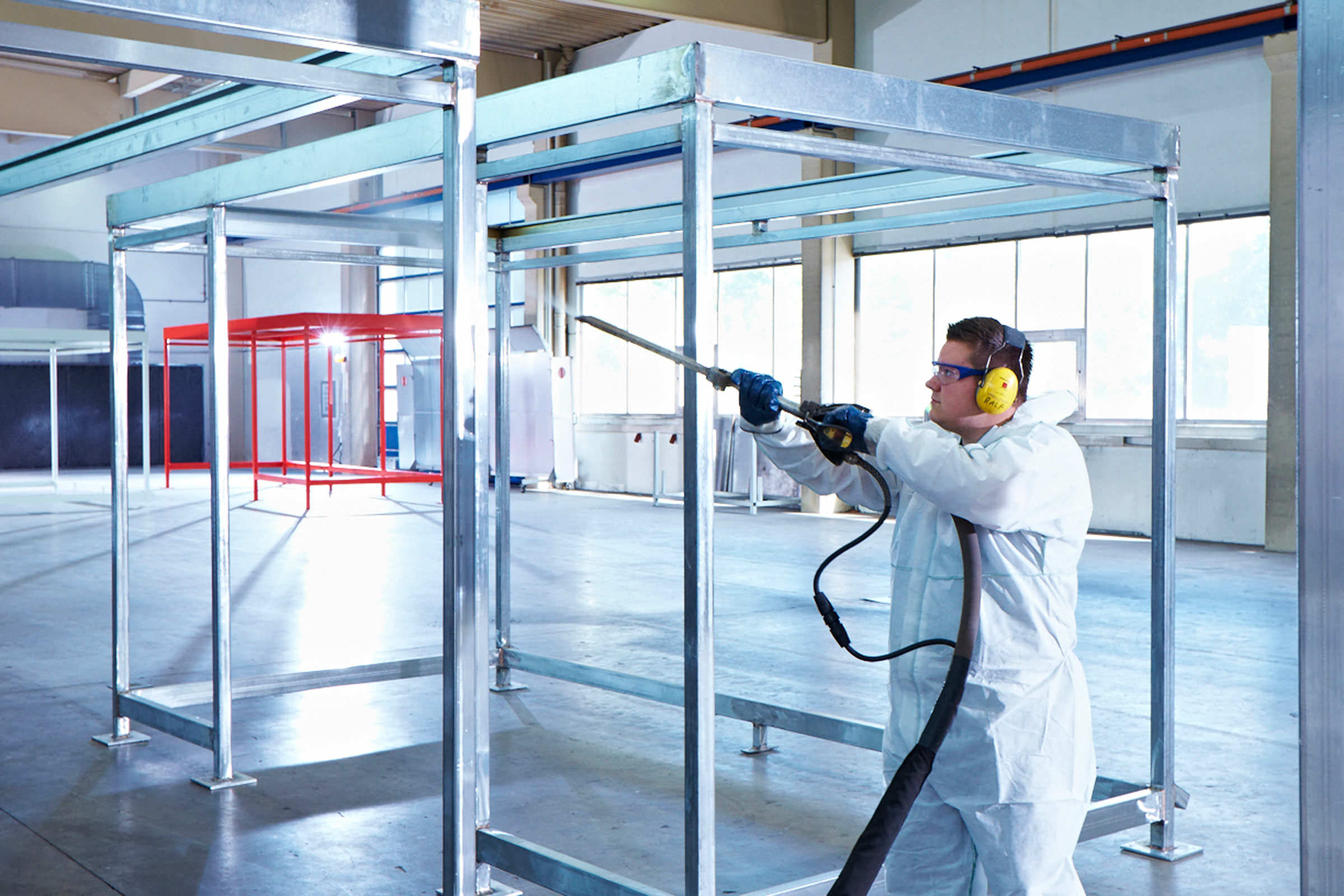Everything in the varnish
Since 2009, WSM has been applying an innovative painting technology that sets new standards in environmental protection and quality. By using dry ice for pre-cleaning, manufacturing-related contaminants can be removed in an environmentally friendly manner and without toxic waste. The subsequent priming and wet painting with a high-solids industrial paint is low-emission and achieves C3 m quality as standard for abrasion resistance and corrosion resistance. But what exactly happens in the process?
First, the welded steel structures are protected, if necessary, with a zinc spray applied to sensitive areas such as welds. This allows temporary storage even in the open air without corrosion damage. When the capacity-related storage time is over, the metal parts to be painted enter the painting hall. There, the pretreatment takes place first.
Ice cold cleaning
This is already where the first innovation takes effect: Usually, metal parts are washed with a highly concentrated solvent before painting to remove scale and grease residues that could impair the subsequent paint application. WSM takes a different approach: “After intensive tests with biomaterial and steam blasting, we decided to use a dry ice process,” explains production manager Hartmut Meyer. In this process, ice particles at minus 76 degrees are sprayed at high pressure onto the metal to be cleaned. Adhering impurities become brittle immediately and are removed by the pressure.
“What’s left is just the dirt on the wall of our hall, which of course you have to clean up regularly, but there’s no polluted water, no polluted atmosphere and no polluted employees,” Meyer said. The employee handling the spray lance only needs hearing protection. The dry ice is a recycled product of the chemical industry and is not produced separately. A new dry ice box is needed every two days.
Environmentally friendly painting
The paint shop is a complex facility. Here, the outside air is drawn in, preheated by a gas surface burner and then blown into the hall at a precisely measured flow rate. To ensure that the metal and paint always react optimally with each other, the temperature and humidity in the hall must be exactly right, and the same applies to the temperature of the component, which is quickly measured with an infrared gun. All important parameters are documented and can be traced back over years.
Propellers on the hall ceiling push the warm air downward, creating an air loop that keeps the structural parts placed on the hall floor dry. Three large-scale exhaust systems convey the hall air back outside. “If you position the components to be painted in front of the extraction units, there is already a very concentrated flow of the spray mist from the paint gun,” Meyer describes.
The coating is applied in two stages: First, a two-component primer made of a polyurethane paint is applied, followed by a top coat, also made of a two-component polyurethane paint. WSM uses water-based high solid coatings that achieve C3 m industrial quality as standard. High-Solid stands for a high solids content of 75 percent and a correspondingly low solvent content. The advantage: high yield and low emissions of volatile organic compounds (VOC).
An electrostatic process further optimizes the coating application. For this purpose, the sprayed-on paint is electrically negatively charged, while the components to be painted are electrically grounded by connection to a neutral conductor and thus receive a positive charge. Paint particles and the component attract each other, and a so-called grip is created: the spray mist from the gun spreads around the metal tubes as if by itself. This means that four sides can be painted in just two work steps. The paint also spreads more easily in openings and hard-to-reach parts. At the same time, the so-called overspray, in which paint flies past the component unused, is avoided. Result: about 20 percent less loss.
Behind the component are the large inlets of the exhaust system. They are used to absorb and remove the remaining air containing paint. This first flows through a filter package, in which particles are trapped, and is then cleaned in several stages. “The end result is a purification level of about 98 percent, which means almost pure exhaust air,” Meyer says. The extraction system detects the condition of the filter packs and automatically signals when replacement is required.
Dry quickly
Component drying takes place right next to the painting area. Here, too, there is innovation: Instead of hot air, particularly powerful halogen spotlights are used. The so-called radiation drying does not use the heat of the lamps, but the radiation they emit. The radiation spectrum used moves beyond the visible range of light and extends to the short-wave infrared range. For humans, this short-wave radiation is harmless. The beams penetrate deep into the materials, where they cause the paint molecules to vibrate, leading to drying from within. In this process, even very thick coating layers cure completely in depth. The workpiece itself is hardly heated, which in the end saves energy with a shorter drying time.
A reflector wall placed opposite the light source reflects the radiation, thus achieving uniform and comprehensive drying. In one hour, this achieves a result that would otherwise take five hours. After this hour, the top coat can be applied, and after another hour the component is ready for further processing in the assembly shop.
Recycle solvents
The organic solvents contained in the high-solids paint are too valuable to be disposed of as hazardous waste. A dedicated distillation plant therefore recovers them from the paint shop exhaust air and the paint-carrying lines, making them reusable. This is done overnight while the freshly painted components dry and await further processing in assembly.
Ready in just one day
From cleaning to finished painting, WSM thus only needs about one working day. “After two hours, you can already touch the painted part, and chemical curing takes place within several days,” explains Meyer, “safe further processing can already take place the following day.”



